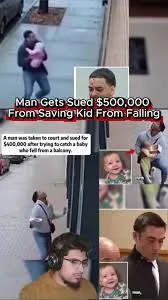The Viral “Man Sued $500K for Saving Child” Story Is a Complete Hoax—Here’s What You Need to Know
The viral story claiming a Chicago man (or Thomas Rivera, Jason Miller, David Walker—the name keeps changing) was sued for $400,000-$500,000 after catching a falling baby is entirely fabricated. No court records, verified news reports, or legal proceedings exist to support this claim. Fact-checkers including Reuters, Snopes, and Creative Learning Guild have confirmed this story is misinformation designed to generate outrage and viral engagement across TikTok, Facebook, and Instagram.
The fake rescue lawsuit has exploded across social media with millions of views, sparking heated debates about Good Samaritan laws, moral decay, and legal injustice. It started as a brief TikTok video and quickly went viral on Facebook and Threads with the startling headline, “Hero Faces $400,000 Lawsuit for Saving Child.”
But there’s one problem: it never happened.
How the Hoax Spread Across Social Media
The story followed a predictable emotional template that made it irresistible to share. A man witnesses a baby falling from a fifth-floor balcony, rushes forward to catch the child, succeeds in saving the baby’s life but causes minor bruises in the process, and then gets sued by the ungrateful parents for hundreds of thousands of dollars.
The claim was so effective because it seemed plausible enough to spark outrage right away. Comment sections overflowed with fury: “This is why good people stop helping.” “The parents should be in jail for child neglect, not suing their hero.”
The details kept changing with each viral iteration—sometimes the rescuer was named Thomas Rivera, other times Jason Miller or David Walker. The location shifted between Chicago, Orlando, and unnamed cities. The lawsuit amount ranged from $300,000 to $500,000. The baby fell from anywhere between the third and fifth floor.
These inconsistencies should have been red flags, but the emotional manipulation was too powerful.
Related article: Sierra Mist Lawsuit, Viral TikTok Controversy Did a TikToker Really Force PepsiCo to Kill Sierra Mist? Shocking Truth Behind the Viral Lawsuit Claims

Why No Court Records Exist
No verified news reports or court records confirm a man named David Walker being sued $300,000 for saving a falling baby in Orlando. The same is true for every version of this story, regardless of the name, location, or dollar amount cited.
Court records are public information. If this lawsuit existed, it would appear in federal or state court databases. Legal journalists, fact-checkers, and concerned citizens have searched exhaustively for any evidence—case numbers, complaint filings, settlement agreements, court dockets—and found nothing.
Multiple users on Threads and other platforms noted the obvious fabrications. “This is fake, There’s no record of this happening or any news sources covering this story. On top of that just look at the video, the person who caught the baby and the person in the court isn’t even the same.”
The videos accompanying these viral posts often splice together unrelated footage—random courthouse clips, unrelated news segments, stock courtroom images—creating a false documentary aesthetic that tricks viewers into believing they’re watching real coverage.
Related lawsuit: Dick Van Dyke Sues Pete Hegseth for $50 Million? The TRUTH Behind the Viral “BEATEN BEATEN – PAY NOW!” Story
The Misinformation Playbook: How Fake Stories Go Viral
Misinformation producers have created a very effective engagement ecosystem by utilizing these instincts. The “man sued for catching baby” hoax demonstrates textbook viral manipulation tactics:
Emotional Exploitation: The story weaponizes empathy and moral outrage. People instinctively want to defend the hero and condemn the ungrateful parents, driving shares and comments.
Plausible Framework: By referencing real legal concepts like “reckless interference” and “disrupted natural trajectory,” the hoax gains false credibility. These sound like actual legal terms someone might use in court.
Algorithmic Amplification: Social media platforms prioritize content that generates strong emotional reactions. A post’s profitability increases with its level of polarization. Misinformation functions similarly to a digital echo chamber in that it feeds off of feelings, reverberates outrage, and gets louder with every share.
Persistence Despite Debunking: Even after fact-checkers expose the hoax, new versions continue circulating. The hoax endures in spite of numerous fact-checks. Every week, new editions are released, occasionally with a higher number of lawsuits or a different nation.
What Real Good Samaritan Laws Actually Say
Despite this story being fake, it sparked legitimate discussions about whether rescuers can be sued for helping during emergencies. The answer: Good Samaritan laws exist specifically to prevent this scenario.
Illinois Good Samaritan Act (745 ILCS 49/) provides civil immunity to anyone who voluntarily provides emergency care without compensation. The law protects ordinary citizens who act in good faith during medical emergencies, car accidents, or life-threatening situations.
Good Samaritan protections exist in all 50 states with similar provisions:
- Protection applies when someone provides emergency care without expectation of payment
- The person must be acting in good faith with reasonable care
- Protection doesn’t cover willful misconduct or gross negligence
- The emergency must be actual—not manufactured or non-urgent
Critical Point: If someone genuinely tried to catch a falling baby and caused minor injuries in the process, Good Samaritan laws would almost certainly protect them from liability. The parents in the fake story claimed the rescuer’s actions “disrupted the natural trajectory” and caused more harm than letting the baby fall—but no court would find a rescuer liable for preventing a potentially fatal fall.
Real Cases Where Rescuers Faced Legal Issues
While the viral baby-catching lawsuit is fake, some actual cases involve rescuers facing legal scrutiny—but for very different reasons:
Lifeguard Criminal Case (Connecticut, 2017): Police charged Stein with risk of injury to a minor and reckless endangerment after he failed to notice a drowning child for nearly 5 minutes. He eventually saved the boy, but prosecutors argued his inattention—not the rescue itself—constituted criminal negligence. “If he performs like that as a lifeguard, we are better off not having him as a lifeguard,” the judge said.
This case involved a professional lifeguard who had a duty to monitor swimmers and violated that duty before belatedly rescuing someone. It’s completely different from a bystander spontaneously intervening in an emergency.
Key Distinction: Professionals with specific duties (lifeguards, security personnel, medical professionals) can face liability for negligence related to their job responsibilities. Random bystanders acting in emergencies receive broader protection under Good Samaritan statutes.

How to Spot Viral Legal Hoaxes
The “man sued for saving baby” story contains red flags common to viral legal misinformation:
No Verifiable Details: Real lawsuits have case numbers, court jurisdictions, attorney names, and specific dates. Viral hoaxes use vague details that make verification impossible.
Changing Names and Locations: The story morphs with each retelling. Real legal cases have consistent parties and jurisdictions.
Missing Credible Sources: Legitimate legal news comes from established outlets (AP, Reuters, local newspapers, legal publications). Hoaxes cite “court documents” without linking to them or mention “local reporters” without identifying specific outlets.
Emotional Manipulation Over Facts: Instead of putting forth a political argument or conspiracy theory, it hides behind emotion, which is a far more effective strategy. If a story seems designed purely to make you angry, verify before sharing.
Video Misdirection: Spliced-together footage from unrelated events creates false authenticity. Real news coverage includes reporter attribution, official sources, and consistent visual documentation.
What This Hoax Reveals About Misinformation
The claim was later refuted as unfounded by fact-checkers such as Reuters and Snopes. Yet the story continues circulating because it serves multiple purposes for content creators seeking viral engagement.
Outrage generates clicks, shares, and ad revenue. Each emotional response feeds the algorithm, pushing false content to more viewers. The hoax also exploits genuine concerns about litigation culture and legal system dysfunction—making people believe it could be true even without evidence.
Although no man has ever been sued for saving a baby in real life, some true stories have been served as the basis for these fictionalizations. Tragic accidents like the 2019 cruise ship case involving a child’s fall have been twisted into oversimplified morality tales that bear no resemblance to actual legal proceedings.
Should You Still Help People in Emergencies?
Yes. Absolutely yes.
This viral hoax should not discourage anyone from providing emergency assistance. Good Samaritan laws exist in all 50 states specifically to protect people who help during emergencies. These laws, which are in place in nations like the US, Canada, and the UK, are specifically made to stop the kind of injustice that was detailed in the widely shared story.
If you witness someone in danger:
- Call 911 immediately
- Provide assistance within your capabilities
- Act in good faith with reasonable care
- Don’t attempt medical procedures beyond your training unless it’s truly life-or-death
- Stay at the scene to provide information to emergency responders
Good Samaritan protections cover reasonable actions taken during genuine emergencies. You cannot be successfully sued for catching a falling child, performing CPR on someone in cardiac arrest, or helping an injured accident victim—as long as you act in good faith without gross negligence.
The Real Lesson: Verify Before You Share
The “man sued for saving baby” hoax demonstrates how easily misinformation spreads when it confirms our worst fears about society. The story felt true because we’ve all heard about frivolous lawsuits and ungrateful people.
But feeling true isn’t the same as being true.
Before sharing viral legal claims:
- Search for the case in court databases
- Look for coverage from established news outlets
- Check fact-checking sites (Snopes, Reuters Fact Check, AP Fact Check)
- Notice if details keep changing across different posts
- Ask: “Would this violate established legal protections?”
The viral baby-catching lawsuit is fake. But the danger of believing and spreading misinformation is very real.
Frequently Asked Questions About the Viral Rescue Lawsuit Hoax
Is the story about a man being sued $500K for catching a falling baby real?
No. This story is completely fabricated misinformation. No court records, verified news reports, or legal proceedings exist for any version of this claim. Fact-checkers have thoroughly debunked it.
Why do people keep sharing this fake story?
The story exploits powerful emotions—outrage at injustice, sympathy for heroes, contempt for ungrateful people. These emotions drive viral engagement, generating clicks and ad revenue for content creators who spread misinformation.
Can you actually be sued for helping someone in an emergency?
Good Samaritan laws in all 50 states protect people who provide emergency assistance in good faith. You cannot be successfully sued for reasonable actions taken to save someone’s life—like catching a falling child or performing CPR.
Are there any real cases where rescuers faced legal problems?
Yes, but they involve very different circumstances. Professional lifeguards or medical personnel can face liability for negligence related to their job duties—not for performing rescues, but for failing to fulfill professional responsibilities before the rescue became necessary.
How can I tell if viral legal stories are fake?
Check for: verifiable details (case numbers, court jurisdictions, attorney names), consistent information across sources, coverage from established news outlets, and existence in court databases. Fake stories use vague details, changing names, emotional manipulation, and spliced unrelated footage.
What should I do if I see someone in danger?
Call 911 immediately and provide assistance within your capabilities. Good Samaritan laws protect reasonable emergency aid. Act in good faith, stay within your training level for medical procedures, and remain at the scene for first responders.
Does this hoax mean I shouldn’t help people in emergencies?
Absolutely not. This fake story should not discourage emergency intervention. Good Samaritan laws exist specifically to protect people who help during life-threatening situations. The scenario described in the viral hoax could never happen in real life because legal protections prevent it.
Disclaimer: This information is for educational purposes only and does not constitute legal advice. Good Samaritan laws vary by state. Consult an attorney specializing in personal injury law for legal guidance regarding specific emergency intervention scenarios.
For more information about consumer protection, personal injury law, and legal rights, visit AllAboutLawyer.com.
About the Author

Sarah Klein, JD, is a licensed attorney and legal content strategist with over 12 years of experience across civil, criminal, family, and regulatory law. At All About Lawyer, she covers a wide range of legal topics — from high-profile lawsuits and courtroom stories to state traffic laws and everyday legal questions — all with a focus on accuracy, clarity, and public understanding.
Her writing blends real legal insight with plain-English explanations, helping readers stay informed and legally aware.
Read more about Sarah
